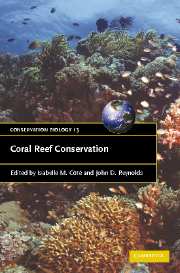Book contents
- Frontmatter
- Contents
- List of contributors
- Foreword
- Preface
- Part I Setting the stage
- 1 Status of coral reefs of the world: summary of threats and remedial action
- 2 Death and resurrection of Caribbean coral reefs: a palaeoecological perspective
- 3 A seascape-level perspective of coral reef ecosystems
- 4 Cold-water coral reefs: status and conservation
- Part II Uses and abuses: ecological and socio-economic issues
- Part III The way forward: tools and approache
- Index
- Plate section
- References
3 - A seascape-level perspective of coral reef ecosystems
Published online by Cambridge University Press: 05 June 2012
- Frontmatter
- Contents
- List of contributors
- Foreword
- Preface
- Part I Setting the stage
- 1 Status of coral reefs of the world: summary of threats and remedial action
- 2 Death and resurrection of Caribbean coral reefs: a palaeoecological perspective
- 3 A seascape-level perspective of coral reef ecosystems
- 4 Cold-water coral reefs: status and conservation
- Part II Uses and abuses: ecological and socio-economic issues
- Part III The way forward: tools and approache
- Index
- Plate section
- References
Summary
INTRODUCTION
Tropical coastal areas are often categorized into three major systems: coral reefs, seagrass beds and mangroves. All three systems often occur in close proximity (Fig. 3.1)and a number of habitats are represented within each (e.g. patterns of habitat zonation in coral reefs: Sheppard, 1982). Many physical and ecological processes transcend individual habitats with some particularly striking examples among the three principal systems. A well-known example is the trapping of riverine sediments in estuarine mangroves that might otherwise discharge onto reefs and cause coral mortality through sedimentation (Pannier, 1979; Torres et al., 2001). Other examples of abiotic linkages include the runoff of cool, low-salinity water from precipitation (Andreéfoueët et al., 2002) and the discharge of hot water from relatively calm lagoons, both of which can cause coral bleaching (reviewed in Glynn, 1993).
Ecological linkages among habitats include the migration of organisms on either an ontogenetic or diurnal basis. Many snappers (Family Lutjanidae), grunts (Haemulidae) and parrotfish (Scaridae) species, for example, undertake ontogenetic shifts in habitat use from seagrass beds or mangroves to their adult coral reef habitat (McFarland et al., 1985; Lindeman et al., 1998; de la Morinieère et al., 2002; Mumby et al., 2004a). Grunts also undertake diurnal migrations from their night-time foraging habitat of seagrass beds to their daytime resting habitat on coral reefs (Ogden and Ehrlich, 1977; Burke, 1995).
- Type
- Chapter
- Information
- Coral Reef Conservation , pp. 78 - 114Publisher: Cambridge University PressPrint publication year: 2006
References
- 4
- Cited by



